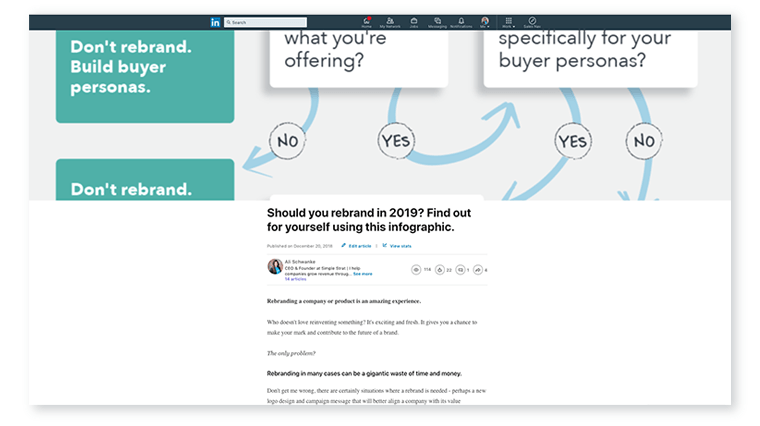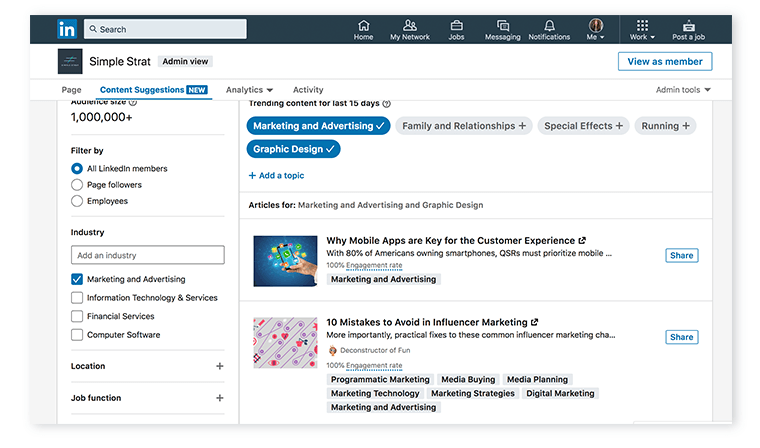It’s easy to find blogs about building your presence on LinkedIn. Post! Add articles! Network and add people!
But we’re shooting a bit higher here. Rather than telling you the basics, here are a few little-known secrets to help you break through the noise.
Remember: In order to become a thought leader, you also must be a leader with good thoughts. Using LinkedIn alone probably can’t get you there.
Your Content
Secret #1: Be unexpected
You won’t be seen as a thought leader if you restate everyone else’s opinion. You have to be unexpected and take a stance that will stand out from a crowd. This means adding value to the conversations you’re in with unique opinions.
“Great thought leadership is successful because it's edgy and takes an angle that is unexpected.” - Adam Fridman
But don’t just take our word for it—take a look at some of the top articles shared on LinkedIn:
- 6 Toxic Behaviors That Push People Away: How to Recognize Them in Yourself and Change Them
- Caffeine: The Silent Killer of Success
- Stop Using These 16 Terms to Describe Yourself
- The 3 Questions People Always Forget to Ask in an Interview

Secret #2: Reshare posts similar to your area of expertise
While it’s important to share original thoughts in order to build your thought leadership, you also want to be seen as a resource by sharing other content in your area of expertise.
But never share posts without adding your own thoughts! If it’s an industry report or relevant topic, let your followers know what you think. Share your insight on the topic so they see that you are aware of what’s happening in the industry and have your own thoughts on what’s taking place.
After all, just sharing another thought leader’s thoughts doesn’t make you one.
Secret #3: Repurpose content
If you’re trying to create content for your personal or company blog AND for LinkedIn, it can be easy to fall behind or, worse, post so inconsistently no one knows when to look for your content. A little-known secret is to repost content from other platforms on LinkedIn with a bit of variety, like a different title. Most sources agree that reposting on LinkedIn doesn’t harm your SEO efforts by creating duplicate content, especially if you link your post back to your site. This gives you an opportunity to get your content in front of a different audience as well as keep your LinkedIn looking fresh and full of new, insightful content.

Secret #4: Learn from content on other networks
What organic posts on your Facebook and Twitter get the most engagement? Take an especially close look Twitter—it’s a great place to test out content ideas to see what happens. So track what people engage with, retweet, and like, and then use that content on LinkedIn.
This will help you to get a quick idea what types of content your audience is looking for and the ways it resonates with them. Test everything: different quotes, formats, images, videos, etc. Then take what worked and share it in a similar format, targeted at your LinkedIn audience.
Secret #5: Use Content Suggestions to write what your audience reads
Another LinkedIn hack is to write what the people in your industry want to read. Seems logical, right? LinkedIn has a tool that can help with this. If you go to your company page, you can look at the Content Suggestions for your industry—you’ll quickly discover what people read and engage with.

Secret #6: Use native videos
LinkedIn prefers native video content. If you have a video that you’ve created for your thought leadership campaign like an industry tip, upload it directly to LinkedIn rather than uploading it to YouTube or Vimeo and sharing the link. The reach of this native content is far greater than external video links.
You’ll see the fruit as you try to reach new members of your community. Another tip is to add captions to your video to provide more context, especially since most viewers watch with their sound off. Just upload an SRT file by clicking “select file” when you upload your video. This makes it easier for viewers to engage, plus increases watch time.
Secret #7: Use trending hashtags and keywords
Make your content accessible and relevant by using keywords and trending hashtags in your posts. This might be top-of-mind for networks like Twitter and Facebook but it can make a difference on LinkedIn as well. Using trending hashtags also shows that you are aware of relevant topics in your industry—and gives you a chance to add your voice in the conversation.
Secret #8: Collaborate with others
LinkedIn is all about connections and collaboration. Use it as an opportunity to collaborate with peers in your industry. One way to do this is by co-authoring articles. This allows you to show your expertise and also share the spotlight with someone else in your industry. In turn, you get to share with their network in addition to yours. It can also be an easy way to build deeper relationships with some of your connections.
Your Profile
Secret #9: Clean up old skills
Go through your skills and clean them up. If you have skills that aren’t relevant to your thought leadership or current role, they might be unnecessary—and might be taking away from more prominent, relevant skills. This can be a quick way to start gaining endorsements for the areas you want to be seen as an expert in. And while you’re at it, endorse some of your connections for their skills. They’ll most likely return the favor.
Secret #10: Ask for recommendations
Building your thought leadership brand on LinkedIn takes a lot of effort and a little bit of hustling. One way to do that is to ask your colleagues and connections for a recommendation. This can help build your credibility in your industry.
Just ask Jim, a contact who saw you speak at a recent event or Lisa, a colleague you worked closely with at your last job. Most of these people won’t naturally go to your page and write a recommendation without you asking. So just ask—the worst they can say is no, and the best they can do is help you build your thought leadership brand.
Obviously, it’s probably not a great idea to ask someone you didn’t work with closely or with whom your relationship ended on a bad note, but if you choose carefully and ask nicely, you’ll be surprised.
Your Connections
It’s a catch 22. If you have a bigger audience, more people will see/share your content. So in order to build your audience, you have to have a big audience?
That’s not necessarily true. Here are a few ways you can build your LinkedIn network:
Secret #11: Be personal
How often do you send/receive generic requests to connect? Show people you value them and make the message personal. It can be a quick and easy personalized message, but show you care and make it something other than “I’d like to add you to my professional network on LinkedIn.”
Really. You want to add me to your network. Are you excited about it? Why do you care? Why should I care? Have we even met?
All these unanswered questions that could quickly, painlessly be solved by saying, “I loved meeting you at [Conference ABC] in [Location D].” OR “I love the work you did for [Project EFG] and would love to stay up-to-date on your work!”
It doesn’t have to be crazy, but get a little bit scrappy and build a connection in their mind of where you met—or at least tell them about work or experience they have that you admire!
Secret #12: Engage with your groups
If you want to build your thought leadership, groups are a good place to start. But don’t just join a group and forget it’s there. Establish your presence in a humble way. Listen to what other members are saying and respond to their posts. From there you can continue to learn from their experiences and start making connections and relationships. Establish yourself in these groups, but do it strategically.
Secret #13: Cross-reference other networks
If someone followed you on Twitter or another network, it doesn’t hurt to send a quick note, asking them to connect on LinkedIn.
A simple message like: Thanks for the follow! I'd be happy to connect on LinkedIn, too: [insert link].
This can help you build your presence across networks and make sure your followers and connections can see what you’re up to!
Secret #14: Retarget your contacts
Another tip used by some LinkedIn experts is downloading your list of connections on LinkedIn and retargeting them on Facebook. Whether you use those ads to promote your personal thought leadership or your company and products, it can be a good tactic to build an audience of people who know and trust you already.
Why not test it?
The moral of the story when it comes to LinkedIn is that it takes work to build your thought leadership, and you need to hustle! Test different types of content to see what works for your audience and what they engage with. Send different connection requests to different contacts to see what resonates.
Get your hands dirty and build your thought leadership kingdom from the ground up.
We can’t wait to see it.

